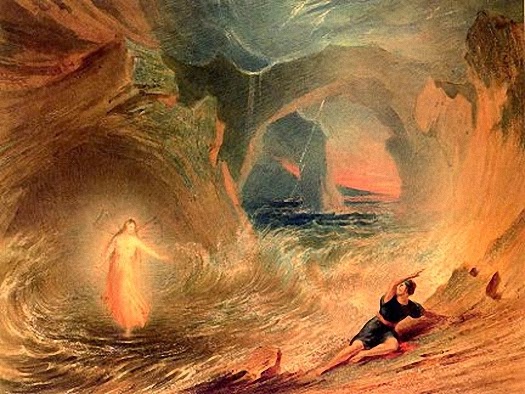The ambiguous nature of Ariel’s magic is also explored in the last image that I allow as an option for students: James Henry Nixon’s The Tempest (n.d.).
I flamed amazement. Sometime I'd divide,
And burn in many places… The fire and cracks
Of sulphurous roaring the most mighty Neptune
Seem to besiege, and make his bold waves tremble,
Yea, his dread trident shake. (1.2.199-200, 204-7)
We see in Nixon’s painting that Ariel himself seems to be glowing as if he is on fire, or “flames amazement.” The landscape in this painting is tumultuous, mirroring Miranda’s description about the sea and sky being at war with one another: “The sky, it seems, would pour down stinking pitch, / But that the sea, mounting to the welkin's cheek, / Dashes the fire out” (1.2. 3-5). In Nixon, the land is caught in this elemental battle as well, and it is difficult to tell where land stops and sea begins. Ariel is an awe-striking creature in this image, poised on a brink between a Christ like and a demonic figure. On the one hand, Nixon references a series of biblical images—the transfigured Christ, Christ walking on the water, Moses parting the Red Sea—but on the other hand, Ferdinand recoils in obvious horror. Nixon’s depiction of Ferdinand accurately represents the text on this point; Ariel explicitly says that Ferdinand goes quite mad with terror: “The King's son Ferdinand, / With hair upstaring—then like reeds, not hair— / Was the first man that leaped; cried, ‘Hell is empty, / And all the devils are here’” (1.2.213-216). Nixon takes Ferdinand’s comment about devils, which in The Tempest is directed to the storm itself, and applies it directly to Ariel. Whereas Fuseli and Fitzgerald emphasize one reading of Ariel over another, Nixon manages to convey both possibilities of Ariel’s character by focusing on the character’s connection to elemental nature through both his beauty and his power.

 RSS Feed
RSS Feed